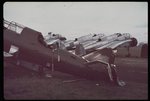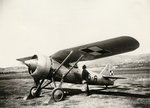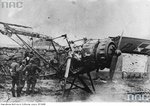After the joint Nazi-Soviet victory in the Invasion of Poland of 1939, a large part of both the flying personnel and technicians of the Polish Airforce were evacuated to Romania and Hungary, from where thousands of them found their way to France. There, in accordance with the Franco-Polish Military Alliance of 1921, and the amendments of 1939, Polish Air units were to be re-created. However, the French headquarters was hesitant in creating large Polish air units and instead most of Polish pilots were attached to small units, so-called keys. Only one large unit was formed, the Groupe de Chasse polonaise I/145 stationed at Mions airfield. However, it was not until May 18, 1940 that it was equipped with planes - and even then these were the completely obsolete Caudron C.714 fighters. After 23 sorties the bad opinion of the plane was confirmed by the front-line pilots. It was seriously underpowered and was no match for the enemy fighters of the epoch. Because of that, on May 25, only a week after it was introduced in active service, French minister of war Guy la Chambre ordered all of C.710s to be withdrawn. However, since the French authorities had no other planes to offer, the Polish pilots ignored the order and continued to use the planes. Although the plane was hopelessly outdated compared to the Messerschmitt Me 109E's it faced, the Polish pilots nevertheless scored 12 confirmed and 3 unconfirmed kills in three battles between June 8 and June 11, losing 9 in the air and 9 more on the ground. Interestingly, among the planes claimed shot down were four Dornier Do 17 bombers, but also three Messerschmitt Bf 109 and five Messerschmitt Bf 110 fighters. The rest of the Polish units were using the Morane-Saulnier M.S.406 fighter, slightly more reliable. Altogether, the Polish pilots flew 714 sorties during the Battle of France. According to Jerzy Cynk, they shot down 51.9 enemy planes (summing fraction kills - or 57 including 16 shared victories), in addition to 3 unconfirmed kills and 6 3/5 damaged. According to Bartłomiej Belcarz they shot down 53 aircraft, including 19 shared with the French. A number of 53 victories makes 7,93% of 693 allied victories in the French campaign. At the same time they lost 44 planes (in combat, accidents and on the ground) and 8 fighter pilots in combat, 1 missing and 4 in accidents.
After the collapse of France in 1940, a large part of the Polish Air Force contingent was withdrawn to the United Kingdom. However, the RAF Air Staff were not willing to accept the independence and sovereignty of Polish forces. Air Marshal Sir Hugh Dowding later admitted he had been "a little doubtful" at first about the Polish airmen. British government informed General Sikorski that at the end of the war, Poland would be charged for all costs involved in maintaining Polish forces in Britain. Plans for the airmen greatly disappointed them: they would only be allowed to join the Royal Air Force Volunteer Reserve, wear British uniforms, fly British flags and be required to take two oaths, one to the Polish government and the other to King George VI of the United Kingdom; each officer was required to have a British counterpart, and all Polish pilots were to begin with the rank of "pilot officer", the lowest rank for a commissioned officer in the RAF. Only after posting would anyone be promoted to a higher grade.[4] Because of that, the majority of much more experienced Polish pilots had to wait in training centres, learning English Command procedures and language, while the RAF suffered heavy losses due to lack of experienced pilots. On June 11, 1940, a preliminary agreement was signed by the Polish and British governments and soon the British authorities finally allowed for creation of two bomber squadrons and a training centre as part of the Royal Air Force.
The first squadrons were 300 and 301 bomber squadrons and 302 and 303 fighter squadrons. The fighter squadrons, flying the Hawker Hurricane, first saw action in the third phase of the Battle of Britain in late August 1940, quickly becoming highly effective. Polish flying skills were well-developed from the Invasion of Poland and the pilots were regarded as fearless and sometimes bordered on reckless. Their success rates were very high in comparison to the less-experienced British Commonwealth pilots.[5] 303 squadron became the most efficient RAF fighter unit at that time.[6] Many Polish pilots also flew in other RAF squadrons. In the following years, further Polish squadrons were created: 304 (bomber, then Coastal Command), 305 (bomber), 306 (fighter), 307 (night fighter), 308 (fighter), 309 (reconnaissance, then fighter), 315 (fighter), 316 (fighter), 317 (fighter), 318 (fighter-reconnaissance) and 663 (air observation/artillery spotting). The fighter squadrons initially flew Hurricanes, then Supermarine Spitfires, and eventually some were equipped with North American Mustangs. Night fighters used by 307 were the Boulton-Paul Defiant, Bristol Beaufighter and the de Havilland Mosquito. The bomber squadrons were initially equipped with Fairey Battles and Vickers Wellingtons, then Avro Lancasters (300 sqn), Handley Page Halifaxs and Consolidated Liberators (301 sqn) and de Havilland Mosquitos and North American Mitchells (305 sqn). 663 flew Auster AOP Mk Vs.
On April 6, 1944, a further agreement was reached and the Polish Air Forces in Great Britain came under Polish command, without RAF officers. This resulted in the creation of a dedicated Polish Air Force staff college at RAF Weston-super-Mare, which remained open until April 1946. After the war, in a changed political situation, their equipment was returned to the British. Due to the fact that Poland ended in Soviet occupation, only a small proportion of the pilots returned to Poland, while the rest remained in exile. A memorial to those Polish pilots killed while on RAF service has been erected at the south-eastern corner of RAF Northolt aerodrome. On the public highway, it is accessible without entering RAF areas. It is adjacent to a junction on the A40 Western Avenue; the official name for this junction is still "Polish War Memorial". The Polish-American fighter ace Francis S. "Gabby" Gabreski flew his first combat missions attached to a Polish RAF squadron. King George VI, on visiting a Polish squadron, asked a Polish airman what was the toughest thing he had to deal with in the war. The reply was "King's Regulations...."
After the collapse of France in 1940, a large part of the Polish Air Force contingent was withdrawn to the United Kingdom. However, the RAF Air Staff were not willing to accept the independence and sovereignty of Polish forces. Air Marshal Sir Hugh Dowding later admitted he had been "a little doubtful" at first about the Polish airmen. British government informed General Sikorski that at the end of the war, Poland would be charged for all costs involved in maintaining Polish forces in Britain. Plans for the airmen greatly disappointed them: they would only be allowed to join the Royal Air Force Volunteer Reserve, wear British uniforms, fly British flags and be required to take two oaths, one to the Polish government and the other to King George VI of the United Kingdom; each officer was required to have a British counterpart, and all Polish pilots were to begin with the rank of "pilot officer", the lowest rank for a commissioned officer in the RAF. Only after posting would anyone be promoted to a higher grade.[4] Because of that, the majority of much more experienced Polish pilots had to wait in training centres, learning English Command procedures and language, while the RAF suffered heavy losses due to lack of experienced pilots. On June 11, 1940, a preliminary agreement was signed by the Polish and British governments and soon the British authorities finally allowed for creation of two bomber squadrons and a training centre as part of the Royal Air Force.
The first squadrons were 300 and 301 bomber squadrons and 302 and 303 fighter squadrons. The fighter squadrons, flying the Hawker Hurricane, first saw action in the third phase of the Battle of Britain in late August 1940, quickly becoming highly effective. Polish flying skills were well-developed from the Invasion of Poland and the pilots were regarded as fearless and sometimes bordered on reckless. Their success rates were very high in comparison to the less-experienced British Commonwealth pilots.[5] 303 squadron became the most efficient RAF fighter unit at that time.[6] Many Polish pilots also flew in other RAF squadrons. In the following years, further Polish squadrons were created: 304 (bomber, then Coastal Command), 305 (bomber), 306 (fighter), 307 (night fighter), 308 (fighter), 309 (reconnaissance, then fighter), 315 (fighter), 316 (fighter), 317 (fighter), 318 (fighter-reconnaissance) and 663 (air observation/artillery spotting). The fighter squadrons initially flew Hurricanes, then Supermarine Spitfires, and eventually some were equipped with North American Mustangs. Night fighters used by 307 were the Boulton-Paul Defiant, Bristol Beaufighter and the de Havilland Mosquito. The bomber squadrons were initially equipped with Fairey Battles and Vickers Wellingtons, then Avro Lancasters (300 sqn), Handley Page Halifaxs and Consolidated Liberators (301 sqn) and de Havilland Mosquitos and North American Mitchells (305 sqn). 663 flew Auster AOP Mk Vs.
On April 6, 1944, a further agreement was reached and the Polish Air Forces in Great Britain came under Polish command, without RAF officers. This resulted in the creation of a dedicated Polish Air Force staff college at RAF Weston-super-Mare, which remained open until April 1946. After the war, in a changed political situation, their equipment was returned to the British. Due to the fact that Poland ended in Soviet occupation, only a small proportion of the pilots returned to Poland, while the rest remained in exile. A memorial to those Polish pilots killed while on RAF service has been erected at the south-eastern corner of RAF Northolt aerodrome. On the public highway, it is accessible without entering RAF areas. It is adjacent to a junction on the A40 Western Avenue; the official name for this junction is still "Polish War Memorial". The Polish-American fighter ace Francis S. "Gabby" Gabreski flew his first combat missions attached to a Polish RAF squadron. King George VI, on visiting a Polish squadron, asked a Polish airman what was the toughest thing he had to deal with in the war. The reply was "King's Regulations...."






















